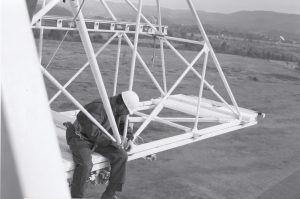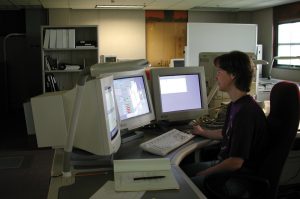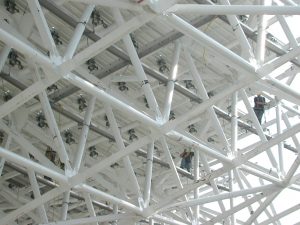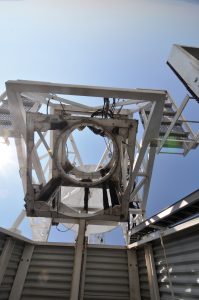The newly assembled 85-foot Howard E. Tatel telescope in Green Bank, West Virginia was the first radio telescope of the NRAO and began observing on February 13, 1959. The Tatel became famous in 1960 for performing the world’s first SETI observations under the direction of Dr. Frank Drake.


Maintenance on High
A telescope engineer rides the traveling feed of the 300-foot telescope that used to be in Green Bank, West Virginia. The 300-foot telescope could not move across the sky, only dip itself up and down. This feed supported receivers on tracks that drove it from side to side above the dish, following the apparent motion of astronomical objects overhead caused by the turning of the Earth.

Operating the GBT
The control room of the Green Bank Telescope sits nearly two miles from the telescope in Green Bank, West Virginia. Astronomers can run their observations from here or remotely, but telescope operators are on duty around the clock. The room’s electronics are shielded inside copper walls and wire-meshed windows.

Maintaining the GBT BUS
The Green Bank Telescope’s 2.3-acre dish is supported by 7,652 pieces of steel welded and joined together in a complex framework known as a backup structure, or BUS. It weighs around 2.3 million pounds. Keeping it strong and sound requires constant vigilance.

On the BUS
Telescope technicians carefully balance on the maintenance trusses to work on the Green Bank Telescope’s backup structure (BUS). The GBT’s 2.3-acre dish is supported by 7,652 pieces of steel welded and joined together in the complex framework. The BUS weighs around 2.3 million pounds. Keeping it strong and sound requires constant vigilance.

Empty Nest
The prime focus of the Green Bank Telescope is equipped with a cage to hold a special receiver. In this photograph, that cage, about the size of a small refrigerator, is empty. The GBT will then observe with its standard receivers out on the turret platform behind the photographer.





